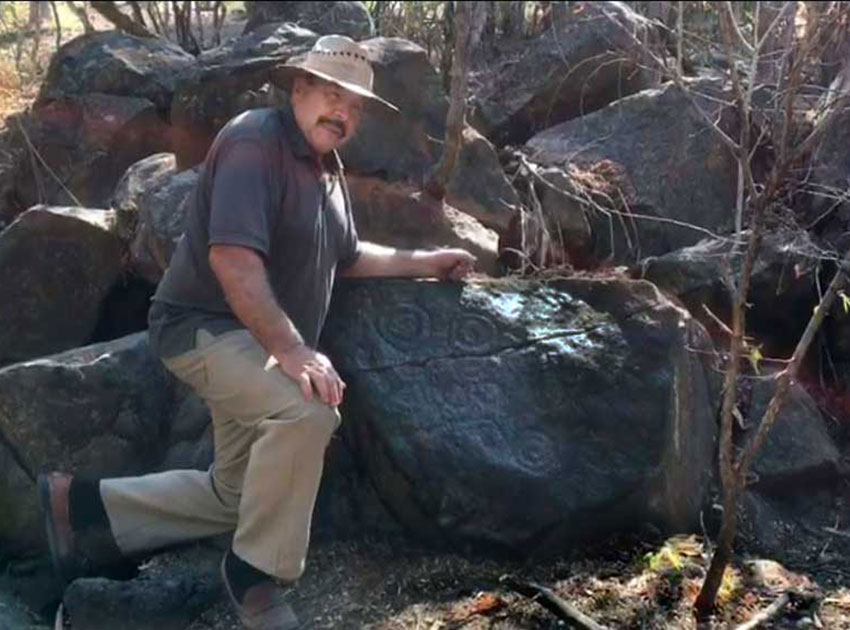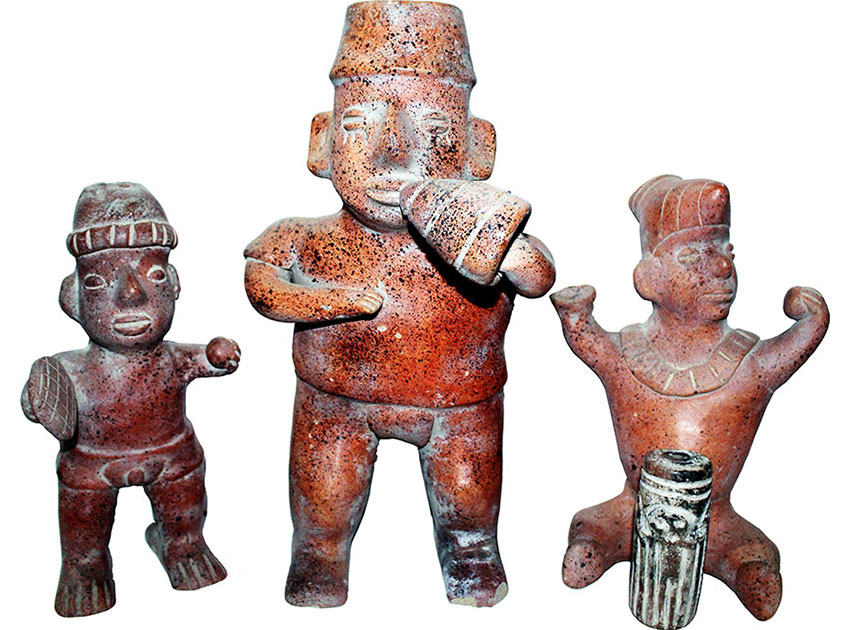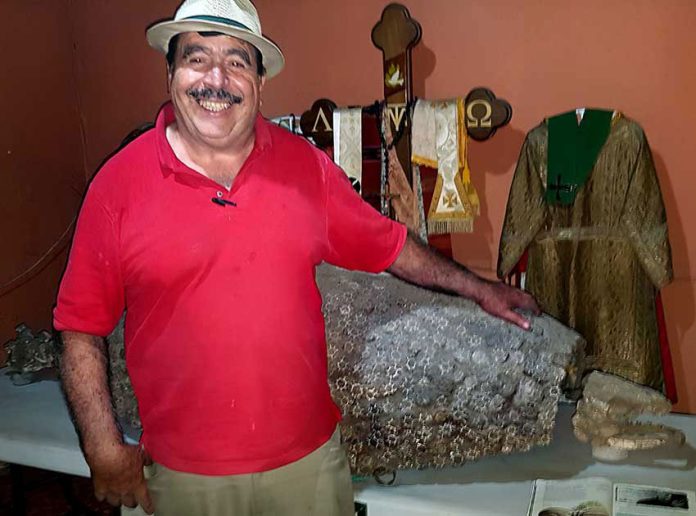El Limón, Jalisco, lies in a verdant valley well off the beaten track, hidden among mountains located halfway between Guadalajara and the Pacific coast.
In El Limón you might expect to find a tienda de abarrotes selling juicy limones and much more. But across the street from the grocery store you might not expect to discover — housed in a beautiful old hacienda — an excellent museum which receives visitors from all over the world, including experts in archaeology and paleontology.
It’s not unusual to find collections of antiquities in rural Mexico, but in most cases you’ll see those ancient figurines and pots on a bookshelf in the collector’s living room, side by side with family photos and knickknacks made in China.
There may not be too many items in those personal collections because the very best daggers and statues plowed up in the local cornfields were sold by Pepe to Pancho, by Pancho to Pablo and by Pablo to Peter Potter who now proudly shows them off to his friends in Pittsburg, Pennsylvania.
This is what usually happens, but every once in a while an unusual person comes along who breaks the chain.

Meet Gabriel de la Asunción Michel Padilla, director of Museo Licho Santana in El Limón.
Gabriel Michel is a big man with a big smile, big enough to melt a glacier, I’d say.
“What got you interested in collecting?” I asked him.
“I wasn’t really a collector at all,” he told me, “until one day, some years ago, when I attended a meeting in Tlajomulco with archaeologist Dr. Phil Weigand and he told us that our state, Jalisco, represents one of the worst cases of archaeological looting in the whole world. Well, those words affected me greatly and I began to collect archaeological artifacts, fossils, historical relics and other important things from the past which came to light in this region.
“From that moment on, I gave my all to this. My main work became visiting those places where they dig up such things and with the help of the National Institute of Anthropology and History, I was finally able to convince the campesinos not to sell these precious items and not to give them away as presents either. To this end I would give them a compensation which was to be a guarantee that they would hold onto that item, that they would promise not to sell it to someone else.
“It may seem unbelievable, but after a while people began to bring me things: not only ancient artifacts, but also sacred art like chalices and priestly vestments and to my surprise, our little community museum ended up with one of the biggest collections in Jalisco.”

Indeed, El Limón’s museum, like those marvelous 16th-century Cabinets of Curiosities, houses just about anything you can think of: pre-classic anthropomorphic figures, daggers designed to remove human hearts, beautiful masks, polychrome plates whose bright colors have not faded after 800 years, old municipal documents, photographs of nearby petroglyphs.
But its most popular attraction, perhaps, is the skeleton and huge shell of a glyptodont, a relative of the armadillo, which appeared in South America around 20 million years ago and later spread north to Mexico. The glyptodont was a truly curious creature, weighing up to 2,000 kilos, protected by a sturdy shell and sporting a tail like a chain mace, which could be swung with enough force to break through the carapace of a competitor.
This and some other very rare fossils have led several paleontologists to the little museum in El Limón, including the National Autonomous University’s Dr. Oscar Carranza, the first Mexican to receive the coveted Morris Skinner prize for an outstanding contribution to paleontology.
While browsing around the antiquities in the museum I came upon several very modern books authored by none other than Gabriel Michel. Several were focused on the history of El Limón and the region, but one of them appeared to be written in verse.
“Gabriel, don’t tell me you are also a poet?”
Thus I stumbled upon one of the most extraordinary works I’ve ever seen, entitled Rapsodias de Anáhuac. It is the story of the conquista and destrucción of Mexico-Tenochtitlán told in blank verse arranged in what the Greeks called rhapsodies: portions of an epic poem adapted for recitation.

“One rapsodia can be recited in three minutes,” Gabriel told me, “and there are a total of 48 of them in my poem. There is, by the way, a whole tradition for epic poems. The very first verses summarize what the entire saga is about and immediately you can see the style of the whole poem.”
That being the case, here are the opening verses of Rapsodias de Anáhuac in Spanish, followed by an unofficial translation into English. Gabriel Michel is, in the meantime, working on an official English version of the poem.
En la casa del Canto, de las Flores,
lugar de los timbales y sonajas,
en la florida casa de Mixcóatl,
donde se forjan cánticos de guerra:
Aquí se Dice, se recita en orden,
de qué manera, portentosamente,
arribaron los hombres de Castilla
a la orilla del agua de los dioses,
donde termina el mar de las turquesas.
And in English:
In the house of flowers and music,
by the blossomy mansion of Mixcóatl,
where are born the canticles of battle,
here is woven in words and recited
how ominously appeared on our shores,
Castilian men from the east,
on the coast of our turquoise waters,
the sea that belongs to our gods.
“We know how you got involved in collecting antiquities,” I said to Gabriel Michel, “but what’s the story behind this epic poem?”
“I was a seminarian for a certain period,” he told me. “I studied Latin and Greek and the humanities and I was greatly inspired by Homer’s two masterpieces, The Iliad and The Odyssey, but something happened when I was studying The Aeneid, Virgil’s epic poem of the founding of ancient Rome.
“I was 13 years old and I said to myself, ‘This is what I should be doing, I should apply this to my own country.’ And I decided then and there I would begin to study the history of the Conquista, first of all from the Spaniards’ point of view, that is to say: The True History of the Conquest of New Spain by Bernal Díaz del Castillo. Then, of course, I examined the writings of those who had been conquered, and I was truly astonished by what I found.”
“I then wrote out my own version of this extraordinary story incorporating the two narratives I had studied and when I finished I said, ‘Now it’s time to put all of it into verse, bit by bit, one event after another,’ and I was inspired by the writings of Saint John of the Cross, who is the very best poet of Spanish literature.”
Jesús Rodríguez Gurrola, award-winning author and professor at the University of Guadalajara, credits Gabriel Michel for being the first to give the story of the destruction of Tenochtitlán the epic form it deserves. And he observes: “In reality, this book tells the story of men who decided to fight against the gods, knowing all along that they would die in the enterprise.”
To visit the museum in El Limón, ask Google Maps to take you to “Museo De Gabriel Michel Padilla.” Driving time from Guadalajara is just over three hours. You can contact Gabriel Michel by email, in Spanish or in English.
[soliloquy id="110972"]
The writer has lived near Guadalajara, Jalisco, for more than 30 years and is the author of A Guide to West Mexico’s Guachimontones and Surrounding Area and co-author of Outdoors in Western Mexico. More of his writing can be found on his website.
